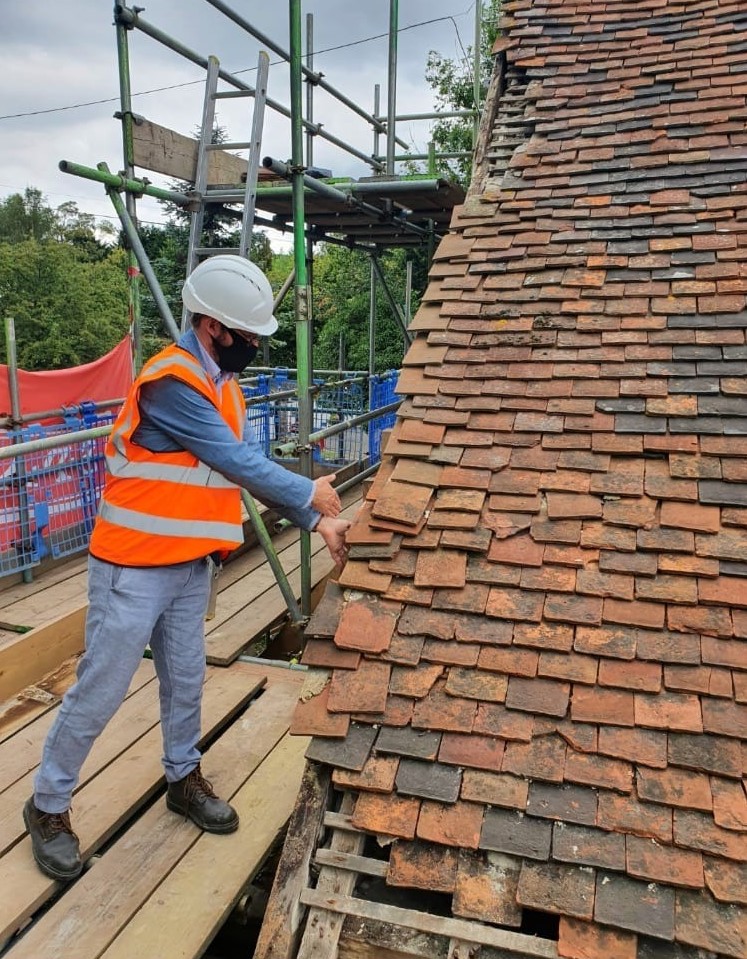St. Andrews Chapel, South Elevation (drawing by Rosalind Webber, 2021)
For the last two years, the Society for the Protection of Ancient Buildings (SPAB) has been surveying and repairing St Andrews Chapel, near Maidstone. Converted to a house after the dissolution, the fifteenth-century chapel is a monument of great rarity and significance, but after decades of neglect it is now in an advanced state of decay. Having recently purchased the building, the SPAB is working to determine the best ways to preserve, conserve and develop the building for future use whilst still retaining its cultural significance to its surrounding area.
I was introduced to the SPAB through The University of Kent, where I am currently finishing my Masters in Architectural Conservation. In 2020, I visited the site of St. Andrew’s Chapel and had a guided tour by Matthew Slocombe and Jonny Garlick around the site. Having only just been uncovered from numerous layers of vegetation, St. Andrew’s lay in a sorry state. Damp had penetrated into the mortar, cracks were appearing in the masonry, and most worryingly of all, the west wall was bowing outwards at an alarming angle. Having already commenced with vital repairs and monitoring and ensuring the building was secure from vandals, the SPAB have been working around the clock to ensure the survival of the building, while using it at the same time for education purposes, documentation and apprenticeships.
In the summer, armed with masks, anti-bacterial, and sun cream, I joined the team at Boxley Abbey in their first socially distanced Working Party. The SPAB rely on the enthusiasm of heritage experts, students and hobbyists to volunteer their time and help bring their projects to life. With fourty people socially distanced on the sites of Boxley Abbey, a Cistercian Monastery founded in 12th century (now a ruin) and St. Andrews, Chapel, the atmosphere was alive with people sharing stories of heritage buildings they had worked on and techniques they had used to sympathetically repair and restore them for future generations.
St. Andrews Chapel, repair of the roof (photo by Rosalind Webber, 2020)
Whilst at the working party, I prepared bricks ready to be laid in a wall by sanding them to uniform size and shape, reconstructed a part of the abbey rubble wall, repointed brickwork on the inner wall of the abbey precincts and witnessed the burning of lime in the site’s bespoke lime kiln! After a tour of the work taking place on St. Andrew’s roof, we explored the newly discovered sewage system (no longer in use) that connected various buildings within the abbey.
As part of the MSc in Architectural Conservation, we are surveying and documenting St. Andrew’s Chapel, taking into consideration the materials used in the construction. We are also identifying the different phases in the development of the building, and will soon develop a conservation plan to ensure the building is functional for future generations.
This includes creating numerous elevations, sections and plans to determine the overall condition of the building. Different sections of the building are constructed out of different materials and this is a key indication into the phasing of St. Andrew’s. As a result, phasing plans, and drawings need to be made to illustrate what the building may have looked like at different stages throughout its history.
Unravelling the wonder that is St. Andrew’s has been puzzling and challenging, but to the most part a true joy and I look forward to working with the SPAB in the future.
St. Andrews Chapel, repair of the roof (photo by Rosalind Webber, 2020)



